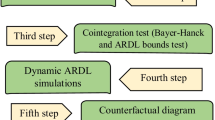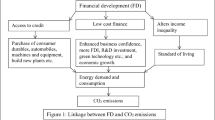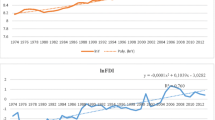Abstract
The aim of this paper is to investigate the possible impact of foreign direct investment inflows (FDI) on environmental pollution and to test the validity of the pollution haven hypothesis (PHH) in the case of Turkey over the period 1970–2020. For this purpose, we apply the Fourier approximation to determine stochastic properties of the variables that are FDI, economic growth, energy consumption, and CO2 emissions used in empirical analysis and the relationship between them. The advantage of the Fourier approximation is capable of capturing possible structural breaks in unknown forms and numbers in the series. According to Fourier KPSS and Fourier FADF tests, all series are stationary at order one, I (1). Fourier Shin and Fourier ADL cointegration tests put forth evidence of the existence of a long-term relationship between CO2, GDP, EC, and FDI. FMOLS expanded with Fourier terms suggesting that FDI has relatively little but a positive impact on CO2 emissions, so we conclude that PHH is valid for Turkey. The other finding reveals that there exists an inverted U-shape relationship between economic growth and CO2 emissions. According to this result, the environmental Kuznets curve (EKC) hypothesis for Turkey is also supported. Another remark of this paper is that energy consumption significantly increases environmental degradation in Turkey. These findings also are supported by Fourier Toda and Yamamoto causality test. There is a causality relationship from GDP, EC, and FDI to CO2 emissions. These findings offer useful recommendations for policymakers: the FDI, which uses new and clean technology, should be encouraged and implemented energy policies should be energy intensity reducer and efficiency increaser for reducing environmental pollution in Turkey.
Similar content being viewed by others
Data availability
All data and materials, as well as software applications, support our published claims and comply with field standards.
Materials availability
All data and materials, as well as software applications, support our published claims and comply with field standards.
Notes
We also applied Engle-Granger (EG) cointegration test for comparison purposes. The EG test statistic is computed as − 6.063, which is statistically significant at a 1% significance level.
References
Acharyya J (2009) Fdi, growth and the environment: evidence from India on CO2 emission during the last two decades. J Econ Dev 34(1):43–58. https://doi.org/10.35866/caujed.2009.34.1.003
Agras J, Chapman D (1999) A dynamic approach to the environmental Kuznets curve hypothesis. Ecol Econ 28(2):267–277. https://doi.org/10.1016/S0921-8009(98)00040-8
Al-mulali U (2012) Factors affecting CO2 emission in the Middle East: a panel data analysis. Energy 44(1):564–569. https://doi.org/10.1016/J.ENERGY.2012.05.045
Al-Mulali U, Ozturk I (2015) The effect of energy consumption, urbanization, trade openness, industrial output, and the political stability on the environmental degradation in the MENA (Middle East and North African) region. Energy 84:382–389. https://doi.org/10.1016/j.energy.2015.03.004
Ang JB (2007) CO2 emissions, energy consumption, and output in France. Energy Policy 35(10):4772–4778. https://doi.org/10.1016/j.enpol.2007.03.032
Apergis N, Payne JE (2009) CO2 emissions, energy usage, and output in Central America. Energy Policy 37(8):3282–3286. https://doi.org/10.1016/j.enpol.2009.03.048
Arouri MEH, Ben Youssef A, M’henni H, Rault C (2012) Energy consumption, economic growth and CO2 emissions in Middle East and North African countries. Energy Policy 45:342–349. https://doi.org/10.1016/j.enpol.2012.02.042
Atici C (2012) Carbon emissions, trade liberalization, and the Japan–ASEAN interaction: a group-wise examination. J Jpn Int Econ 26(1):167–178. https://doi.org/10.1016/J.JJIE.2011.07.006
Banerjee P, Arčabić V, Lee H (2017) Fourier ADL cointegration test to approximate smooth breaks with new evidence from crude oil market. Econ Model 67:114–124. https://doi.org/10.1016/j.econmod.2016.11.004
Becker R, Enders W, Hurn S (2004) A general test for time dependence in parameters. J Appl Econ 19(7):899–906. https://doi.org/10.1002/jae.751
Becker R, Enders W, Lee J (2006) A stationarity test in the presence of an unknown number of smooth breaks. J Time Ser Anal 27(3):381–409. https://doi.org/10.1111/j.1467-9892.2006.00478.x
Bölük G, Mert M (2015) The renewable energy, growth and environmental Kuznets curve in Turkey: an ARDL approach. In: In Renewable and Sustainable Energy Reviews, 52nd edn. Elsevier Ltd, Oxford, pp 587–595. https://doi.org/10.1016/j.rser.2015.07.138
Bulut U, Ucler G, Inglesi-Lotz R (2021) Does the pollution haven hypothesis prevail in Turkey? Empirical evidence from nonlinear smooth transition models. Environ Sci Pollut Res 28:38563–38572. https://doi.org/10.1007/s11356-021-13476-7
Charfeddine L (2017) The impact of energy consumption and economic development on ecological footprint and CO2 emissions: evidence from a Markov switching equilibrium correction model. Energy Econ 65:355–374. https://doi.org/10.1016/j.eneco.2017.05.009
Cole MA (2004) Trade, the pollution haven hypothesis and the environmental Kuznets curve: examining the linkages. Ecol Econ 48(1):71–81. https://doi.org/10.1016/j.ecolecon.2003.09.007
Cole MA, Elliott RJR (2005) FDI and the capital ıntensity of “dirty” sectors: a missing piece of the pollution haven puzzle. Rev Dev Econ 9(4):530–548. https://doi.org/10.1111/j.1467-9361.2005.00292.x
Coondoo D, Dinda S (2008) Carbon dioxide emission and income: a temporal analysis of cross-country distributional patterns. Ecol Econ 65(1):375–385. https://doi.org/10.1016/j.ecolecon.2007.07.001
De Camargo Fiorini P, Jabbou CJC, de Sousa Jabbour ABL, Stefanelli NO, Fernando Y (2019) Interplay between information systems and environmental management in ISO 14001-certified companies: ımplications for future research on big data. Manag Decis 57(8):1883–1901. https://doi.org/10.1108/MD-07-2018-0739
Destek MA, Ozsoy FN (2015) Relationships between economic growth, energy consumption, globalization, urbanization and environmental degradation in Turkey. Int J Energy Stat 03(04):1550017. https://doi.org/10.1142/S2335680415500179
Dickey DA, Fuller WA (1979) Distribution of the estimators for autoregressive time series with a unit root. J Am Stat Assoc 74(366a):427–431, 28. https://doi.org/10.1080/01621459.1979.10482531
Dinda S (2004) Environmental Kuznets curve hypothesis: a survey. Ecol Econ 49(4):431–455. https://doi.org/10.1016/j.ecolecon.2004.02.011
Enders W, Jones P (2016) Grain prices, oil prices, and multiple smooth breaks in a VAR. Stud Nonlinear Dyn Econ 20(4):399–419. https://doi.org/10.1515/snde-2014-0101
Enders W, Lee J (2012a) A unit root test using a fourier series to approximate smooth breaks. Oxf Bull Econ Stat 74(4):574–599. https://doi.org/10.1111/j.1468-0084.2011.00662.x
Enders W, Lee J (2012b) The flexible Fourier form and Dickey-Fuller type unit root tests. Econ Lett 117(1):196–199. https://doi.org/10.1016/j.econlet.2012.04.081
Engle RF, Granger CWJ (1987) Co-ıntegration and error correction: representation, estimation, and testing. Econometrica 55(2):251–276. https://doi.org/10.2307/1913236
Global Carbon Atlas (2020) CO2 emissions. Available online: http://www.globalcarbonatlas.org/en/CO2-emissions. Accessed 15 Dec 2021
Gökmenoğlu K, Taspinar N (2016) The relationship between CO2 emissions, energy consumption, economic growth and FDI: the case of Turkey. J Int Trade Econ Dev 25(5):706–723. https://doi.org/10.1080/09638199.2015.1119876
Gray KR (2002) Foreign direct investment and environmental impacts - ıs the debate over? Rev Eur Commun Int Environ Law 11(3):306–313. https://doi.org/10.1111/1467-9388.00329
Grossman G, Krueger A (1991) Environmental ımpacts of a North American Free Trade Agreement. National Bureau of Economic Research, Cambridge, p 3914. https://doi.org/10.3386/w3914
Grossman GM, Krueger AB (1995) Economic growth and the environment. Source: Q J Econ 110(2):353–377. https://doi.org/10.2307/2118443
Halicioglu F (2009) An econometric study of CO2 emissions, energy consumption, income and foreign trade in Turkey. Energy Policy 37(3):1156–1164. https://doi.org/10.1016/j.enpol.2008.11.012
Haug AA, Ucal M (2019) The role of trade and FDI for CO2 emissions in Turkey: nonlinear relationships. Energy Econ 81:297–307. https://doi.org/10.1016/j.eneco.2019.04.006
Holtz-Eakin D, Selden TM (1995) Stoking the fires? CO2 emissions and economic growth. J Public Econ 57(1):85–101. https://doi.org/10.1016/0047-2727(94)01449-X
Katircioglu ST (2014) International tourism, energy consumption, and environmental pollution: the case of Turkey. In: In Renewable and Sustainable Energy Reviews, 36th edn. Elsevier Ltd, Oxford, pp 180–187. https://doi.org/10.1016/j.rser.2014.04.058
Kearsley A, Riddel M (2010) A further inquiry into the pollution haven hypothesis and the environmental Kuznets curve. Ecol Econ 69(4):905–919. https://doi.org/10.1016/j.ecolecon.2009.11.014
Kirikkaleli D, Kalmaz DB (2020) Testing the moderating role of urbanization on the environmental Kuznets curve: empirical evidence from an emerging market. Environ Sci Pollut Res 27(30):38169–38180. https://doi.org/10.1007/s11356-020-09870-2
Kirkulak B, Qiu B, Yin W (2011) The impact of FDI on air quality: evidence from China. J Chin Econ Foreign Trade Stud 4(2):81–98. https://doi.org/10.1108/17544401111143436
Koçak E, Şarkgüneşi A (2018) The impact of foreign direct investment on CO2 emissions in Turkey: new evidence from cointegration and bootstrap causality analysis. Environ Sci Pollut Res 25(1):790–804. https://doi.org/10.1007/s11356-017-0468-2
Kwiatkowski D, Phillips PCB, Schmidt P, Shin Y (1992) How sure are we that economic time series have a unit root? J Econ 54:159–178. https://doi.org/10.1016/0304-4076(92)90104-Y
Lee JW (2013) The contribution of foreign direct investment to clean energy use, carbon emissions and economic growth. Energy Policy 55:483–489. https://doi.org/10.1016/j.enpol.2012.12.039
Mavioglu OY, Varol P, Tamtürk D (2019) Environmental law and practice in Turkey: overview. Thomson Reuters Pract, Law
Merican Y, Yusop Z, Noor ZM, Law SH (2007) Foreign direct ınvestment and the pollution in five ASEAN Nations. J Econ Manag 1(2):245–261
Nazlioglu S, Gormus NA, Soytas U (2016) Oil prices and real estate investment trusts (REITs): gradual-shift causality and volatility transmission analysis. Energy Econ 60:168–175. https://doi.org/10.1016/j.eneco.2016.09.009
Omri A, Nguyen DK, Rault C (2014) Causal interactions between CO2 emissions, FDI, and economic growth: evidence from dynamic simultaneous-equation models. Econ Model 42:382–389. https://doi.org/10.1016/j.econmod.2014.07.026
Opoku EEO, Adams S, Aluko OA (2021) The foreign direct investment-environment nexus: does emission disaggregation matter? Energy Rep 7:778–787. https://doi.org/10.1016/j.egyr.2021.01.035
Ozcan B (2013) The nexus between carbon emissions, energy consumption and economic growth in Middle East countries: a panel data analysis. Energy Policy 62:1138–1142. https://doi.org/10.1016/j.enpol.2013.07.016
Ozturk I, Acaravci A (2010) CO2 emissions, energy consumption and economic growth in Turkey. In: Renewable and Sustainable Energy Reviews, 14, 9 edn. Elsevier Ltd., Oxford. https://doi.org/10.1016/j.rser.2010.07.005
Pao HT, Tsai CM (2010) CO2 emissions, energy consumption and economic growth in BRIC countries. Energy Policy 38(12):7850–7860. https://doi.org/10.1016/j.enpol.2010.08.045
Pao HT, Tsai CM (2011) Multivariate Granger causality between CO2 emissions, energy consumption, FDI (foreign direct investment) and GDP (gross domestic product): evidence from a panel of BRIC (Brazil, Russian Federation, India, and China) countries. Energy 36(1):685–693. https://doi.org/10.1016/J.ENERGY.2010.09.041
Pata UK (2018) The influence of coal and noncarbohydrate energy consumption on CO2 emissions: revisiting the environmental Kuznets curve hypothesis for Turkey. Energy 160:1115–1123. https://doi.org/10.1016/j.energy.2018.07.095
Perkins R, Neumayer E (2009) Transnational linkages and the spillover of environment-efficiency into developing countries. Glob Environ Chang 19(3):375–383. https://doi.org/10.1016/j.gloenvcha.2009.05.003
Perron P (1989) The great crash, the oil price shock, and the unit root hypothesis. Econometrica 57(6):1361. https://doi.org/10.2307/1913712
Phillips PCB, Hansen BE (1990) Statistical inference in instrumental variables regression with i(1) processes. Rev Econ Stud 57(1):99–125. https://doi.org/10.2307/2297545
Seker F, Ertugrul HM, Cetin M (2015) The impact of foreign direct investment on environmental quality: a bounds testing and causality analysis for Turkey. In: In Renewable and Sustainable Energy Reviews, 52nd edn. Elsevier Ltd, Oxford, pp 347–356. https://doi.org/10.1016/j.rser.2015.07.118
Shahbaz M, Nasreen S, Abbas F, Anis O (2015) Does foreign direct investment impede environmental quality in high-, middle-, and low-income countries? Energy Econ 51:275–287. https://doi.org/10.1016/j.eneco.2015.06.014
Shahbaz M, Nasir MA, Roubaud D (2018) Environmental degradation in France: the effects of FDI, financial development, and energy innovations. Energy Econ 74:843–857. https://doi.org/10.1016/j.eneco.2018.07.020
Soytas U, Sari R (2003) Energy consumption and GDP: causality relationship in G-7 countries and emerging markets. Energy Econ 25(1):33–37. https://doi.org/10.1016/S0140-9883(02)00009-9
Soytas U, Sari R, Ewing BT (2007) Energy consumption, income, and carbon emissions in the United States. Ecol Econ 62(3–4):482–489. https://doi.org/10.1016/j.ecolecon.2006.07.009
Sun C, Zhang F, Xu M (2017) Investigation of pollution haven hypothesis for China: an ARDL approach with breakpoint unit root tests. J Clean Prod 161:153–164. https://doi.org/10.1016/j.jclepro.2017.05.119
Talukdar D, Meisner CM (2001) Does the private sector help or hurt the environment? Evidence from carbon dioxide pollution in developing countries. World Dev 29(5):827–840. https://doi.org/10.1016/S0305-750X(01)00008-0
Tang CF, Tan BW (2015) The impact of energy consumption, income and foreign direct investment on carbon dioxide emissions in Vietnam. Energy 79:447–454. https://doi.org/10.1016/j.energy.2014.11.033
Taylor MS (2005) Unbundling the pollution haven hypothesis. Advances. Econ Anal Policy 3(2). https://doi.org/10.2202/1538-0637.1408
Toda HY, Yamamoto T (1995) Statistical inference in vector autoregressions with possibly integrated processes. J Econ 66(1–2):225–250. https://doi.org/10.1016/0304-4076(94)01616-8
Tsong CC, Lee CF, Tsai LJ, Hu TC (2016) The Fourier approximation and testing for the null of cointegration. Empir Econ 51(3):1085–1113. https://doi.org/10.1007/s00181-015-1028-6
Tutulmaz O (2015) Environmental Kuznets curve time series application for Turkey: why controversial results exist for similar models? In: In Renewable and Sustainable Energy Reviews, 50th edn. Elsevier Ltd, Oxford, pp 73–81. https://doi.org/10.1016/j.rser.2015.04.184
Walter I, Ugelow JL (1979) Environmental policies in developing countries. Ambio Technology, Development and Environmental Impact 8(Issue 3):102–109
Wang C, Jiayu C (2019) Analyzing on the ımpact mechanism of foreign direct ınvestment(FDI) to energy consumption. Energy Procedia 159:515–520. https://doi.org/10.1016/j.egypro.2018.12.006
Wang Q, Zhao M, Li R, Su M (2018) Decomposition and decoupling analysis of carbon emissions from economic growth: a comparative study of China and the United States. J Clean Prod 197:178–184. https://doi.org/10.1016/j.jclepro.2018.05.285
Yavuz CN (2014) CO2 Emission, energy consumption, and economic growth for Turkey: evidence from a cointegration test with a structural break. Energy Sources, Part B: Econ Plan Policy 9(3):229–235. https://doi.org/10.1080/15567249.2011.567222
Zarsky L (1999) Havens, halos and spaghetti: untangling the evidence about foreign direct ınvestment and the environment. in Foreign Direct Investment and the Environment. OECD Publications Servise, Hague, pp 47–74
Zhang C, Zhou X (2016) Does foreign direct investment lead to lower CO2 emissions? Evidence from a regional analysis in China. Renew Sust Energ Rev 58:943–951. https://doi.org/10.1016/j.rser.2015.12.226
Zivot E, Andrews DWK (2002) Further evidence on the great crash, the oil-price shock, and the unit-root hypothesis. J Bus Econ Stat 20(1):25–44. https://doi.org/10.1198/073500102753410372
Author information
Authors and Affiliations
Contributions
Nilgun Cil: Conceptualization, formal analysis, investigation, resources, methodology, software, and writing—review and editing.
Corresponding author
Ethics declarations
Ethics approval
Not applicable.
Consent to participate
Not applicable.
Consent for publication
Not applicable.
Competing interests
The author declares no competing interests.
Additional information
Responsible Editor: Eyup Dogan
Publisher’s note
Springer Nature remains neutral with regard to jurisdictional claims in published maps and institutional affiliations.
Appendix A
Appendix A
Rights and permissions
Springer Nature or its licensor holds exclusive rights to this article under a publishing agreement with the author(s) or other rightsholder(s); author self-archiving of the accepted manuscript version of this article is solely governed by the terms of such publishing agreement and applicable law.
About this article
Cite this article
Cil, N. Re-examination of pollution haven hypothesis for Turkey with Fourier approach. Environ Sci Pollut Res 30, 10024–10036 (2023). https://doi.org/10.1007/s11356-022-22800-8
Received:
Accepted:
Published:
Issue Date:
DOI: https://doi.org/10.1007/s11356-022-22800-8




